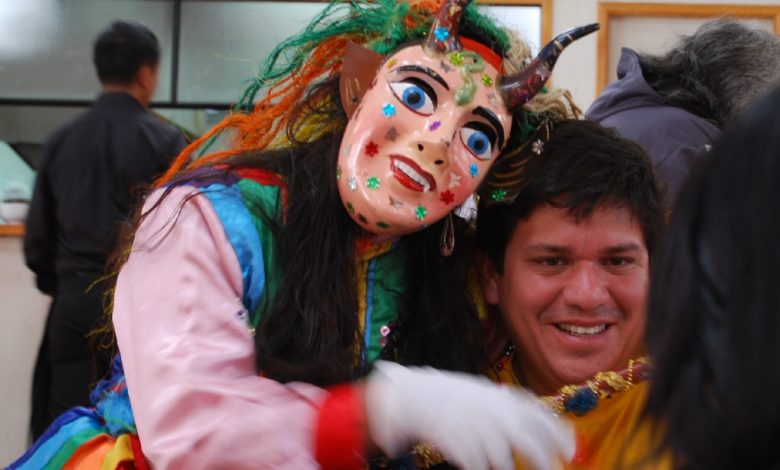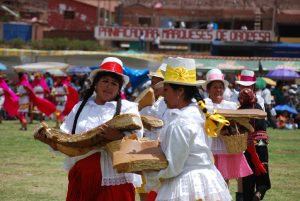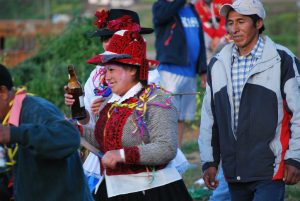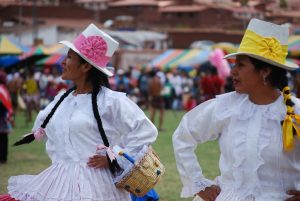Happiness and Joy, the Main Value of Cuzco’s Fiestas

In Cuzco you often hear the sounds of a fiesta, whether a grand social event that embraces the entire population or the smaller gatherings and celebrations of families and friends. Like public rituals most everywhere, these do many things. Ritual Studies goes into those in depth, but in Cuzco one thing more than any other keeps popping out at me whenever I go to one or when I hear people talk about them
That word is joy, although it could also be translated happiness. In English these two are different but the Spanish alegría falls in between. I have been coming here long enough to know the tragic side, the difficult and sad side. Life can be very hard here because of poverty and unstable family relationships, as well as intense politics. I have no doubt there is much suffering.
But when it comes to these rituals of feasting people almost uniformly cite joy. But even there I know people can get very drunk, fights can break out, people can die, and relationships can be radically strained. Nevertheless, joy is the value people cite.
It is more than an ideal, the kind of idealistic denial so common among people. When you ask people to tell you about happiness or joy and where they find it, they will tell you it is in the fiestas and family gatherings, when people get together, share food, drink, and often dance. The words joy or happiness and feasts seem seamlessly stitched together in Cuzco’s life.

In the United States I do not hear people speak of parties as exemplifying joy, or even happiness. The operative word is “fun”. And if I ask people about ritual, I think they mostly see it as serious, where weight falls on each action.

As a result, if I am right, then Cuzco lives a different experience than does the United States. Feasts not only express joy, they make it, and are a major place where people experience it.
The Quechua word for joy or happiness is kusi, a word that has much valence. It is the name of the second plaza of the city, Kusipata, one that was in Inca times across the Saphi river from the first plaza, called generally the Plaza de Armas. Intriguingly, the name of this second square, the big ritual space in front of the Cathedral and the Compañía de Jesus (the Jesuit’s Church) is a matter of argument.
People like Jorge Flores following George Squier call it Haucaypata, a place of seriousness or the sacred. But in contemporary Quechua dictionaries hawkay (as the root verb is spelled today) means to celebrate or play. It also refers to July and its celebrations as well as to the fall.
In contrast, María Rostworowski calls it the Aukaypata, from the root auka or enemy. Of course enemies are also ancestors. Many others call it the Waqaypata, the place of sorrow, perhaps in contrast to the other plaza named for joy. In any case, it is worth noting that the Plaza whose name is not at all disputed, of the two main ones, is the one that carries a name which is the same as the central value expressed around feasts and as a model for life, kusi, regocijo, or joy.

Today the Plaza of the confusing ancestral name is large and much used for all kinds of celebrations and social events, while the other still across a now hidden stream and next to the municipal government building has an established and accepted ancestral name. Today, this plaza is often the staging place for dance groups and others who are getting ready to process through the Plaza de Armas, as well as a shady place with a large gurgling fountain which it both sunny and shady
In any case, it is worth noting that the Plaza whose name is not at all disputed, of the two main ones, is the one that carries a name which is the same as the central value expressed in feasts and as a model for life, kusi, regocijo, or joy.
To understand this value better it is worth noticing what accompanies it when people talk about it today in Cuzco. They generally relate happiness with coming together, or being together. The manifestation of these, both the coming and the being, is sharing food and drink, while also sharing laughter and humor: good stories, anecdotes, and jokes. The language of sharing, and the actions of sharing food and drink, come together in dancing, in movement.
Many times, in feasts, I have heard people tell a dancer to dance with more alegría, more joy, more liveliness. This latter, liveliness along with abundance, seem to accompany happiness and typify it.
But I think the root is the sharing, the coming together. This receives a strong focus in many Andean arts. In Cuzco people will generally relate it to the norm of ayni, which is reciprocity. In English this word suggests me helping you followed by you helping me.

In Cuzco, though, I think ayni is more like what anthropologists call “generalized reciprocity”, that is doing stuff for each other without expectation of immediate and relatively equal recompense. But I think it is more. I think the word refers to coming together, with the together marked and emphasized in the idea of happiness and joy, or kusikuy, to have kusi.
When you see people laughing, smiling, feasting, dancing in this city, you see not only one of the main means of bringing their society together, you also see manifested an Andean norm which exemplifies the good life, as well as the life of fertility, reproduction, and abundance. As a result, when people see feasts and happiness as joined, they are bringing values that other cultures might see as ritual joined with salvation, or ritual and efficacy or seriousness, or even just parties and fun. Happiness, in Cuzco’s sense, speaks to making the world work and also be transformed. It is about joy.




